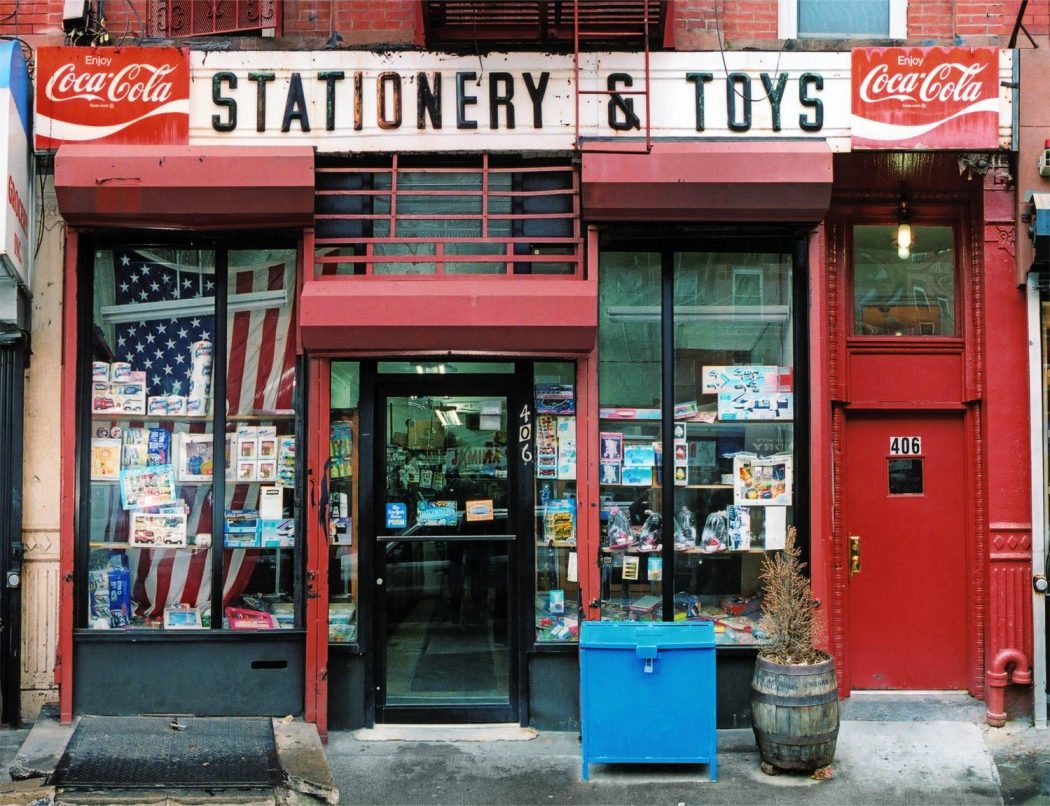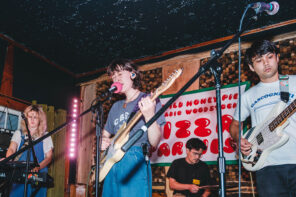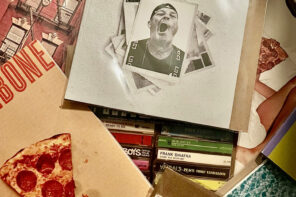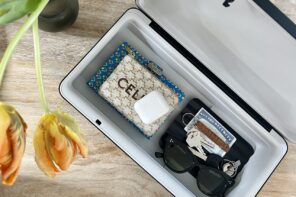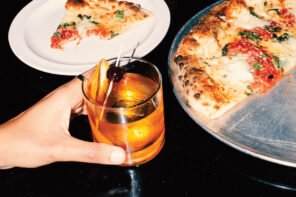James and Karla Murray may very well be the only married couple whose has seen nearly all of NYC without ever sitting on a ketchup red, double decker tour bus for an entire week straight. The Murray’s tour also leaves out the four espresso’d tour guide sporting a headset from 2006 and pointing out where B-list celebrities used to buy their groceries. Instead, the photographing duo has spent the last two decades on foot—documenting NYC’s most alluring and longstanding storefronts, interviewing each’s business owner(s) and carefully curating it all into a series of photo books that offer readers an unforgettable field trip through, and face-to-face introduction with, the city’s most regarded neighborhoods and their flagship small businesses.
We recently got touch with the two photographers-turned-historians—who just published their second critically-acclaimed photo book of NYC storefronts—and picked their brains on what the last ~20 years of exploring nearly every inch of the city has been like, their preference for publishing hard copies instead of posting to social media, and the one street + neighborhood that every person living and/or visiting Manhattan should walk from start to finish without blinking.
Hi James and Karla. Can you both recall what first drew you both into capturing the city’s storefronts?
The idea to capture the disappearing storefronts came about when we were photographing the city’s streets for an entirely different project. During the late 1990s, we were combing the streets of NYC searching out and documenting its graffiti art scene for a book we were making that also involved large-scale photography, Broken Windows-Graffiti NYC. We were traveling to many distant neighborhoods of the city because most graffiti is not found in the center of Manhattan, but in its boroughs.
The nature of graffiti art is such that it constantly changes as new art covers what had been there before. We would often return to the same location and see new artwork that had been painted, so we often had to make many trips to the same block. Despite the short time frame between visits however, we noticed that some blocks looked drastically different.
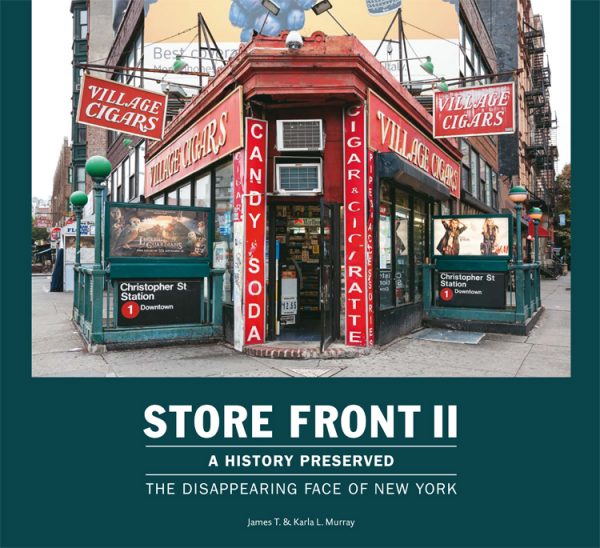
Photo: James and Karla Murray
Many neighborhood stores had closed, or we would come across ‘old’ stores, still in business, but somehow different. They were either refaced, remodeled, or original signage had been substituted with new, bright and shiny plastic awnings. The whole look and feel of the neighborhood had changed and much of its individuality and charm had gone.
We made it our mission to thoroughly document the small unique “mom and pop” stores of the city when we first began to notice the alarming rate at which these shops were disappearing. Our first book on the subject, Store Front: The Disappearing Face of New York, published in 2008 and our recent follow-up book, Store Front II—A History Preserved, both focus on the documentation of small independent businesses in the five boroughs of the city.
We were at first visually attracted to the mom and pop shops original signage, including both hand-painted signs and neon signs, architectural adornment, and hand-made window displays. But even though the project was initially primarily driven by visual aesthetics, after speaking with only a handful of the storeowners, the scope of the project became larger as we discovered that many of the shop owners had fascinating stories to share about the joys and struggles of surviving as a family business in New York City.
And was that attraction to storefronts mutually-timed or did it take some marital convincing on one of your parts?
We were both very passionate about the artistic merit and social importance of our “Store Front” project from the start! It definitely became an obsession for us as well as a race against time to document all of the small storefronts that we find on our walks through the city.
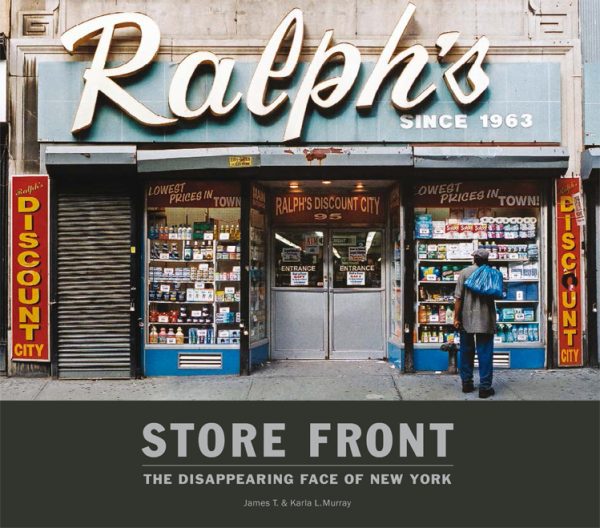
Photo: James and Karla Murray
Besides producing a large body of work that showcases the vibrant facades of NYC’s tried-and-true businesses, what importance have you found and/or placed on documenting these storefronts?
We know that New York is always changing and evolving but were alarmed at the rate of change in the small retail establishments we were seeing throughout the many distinct neighborhoods of the city in all five boroughs. The small stores that make up each neighborhood, contributing to the spirit and cultural diversity of the streets, have been threatened by economic pressures, the takeover of chain stores with their uniform branding, and rapidly changing demographics.
In New York in particular, the neighborhood store has always been a foothold for new immigrants and a comfortable place where familiar languages are spoken, where ethnic foods and culture are present. These shops are lifelines for their communities, vital to the residents who depend on them for a multitude of needs. When these shops fail, the neighborhood is aversely affected. These old storefronts have the city’s history etched in their facades. They set the pulse, life, and texture of their communities.
We hope that our project acts an artistic intervention to help draw attention to and preserve the small shops whose existence is essential to the unique and colorful atmosphere of the city’s streets.
It wasn’t long ago that taking a photo of the front of someone’s business was likely met with shouted question, if not led to a owner chasing the photographer with a broom repurposed as a weapon. In your experience, what’s the proper + most respectable way to setting up camera and photographing the front of a business?
We would always try to introduce ourselves to the store owner prior to photographing the businesses facade. We would also ask them questions about the history of their shop and many storeowners felt honored that we would take the time to photograph their business and ask them pointed questions. We often sat down with them for hours, talking and reminiscing. We felt welcomed into their ‘homes’ and many wouldn’t let us leave without taking ‘tokens’ of their appreciation such as loaves of bread, pastries, sausages, or pizza. We can honestly say that we NEVER were chased away.
In addition to photographing, you also interview the owners/employees of these businesses. Who’ve been some of your favorite interviews and what are some of the cool things that’ve come of building relationships with those featured?
One of our favorite interviews was with Katy Keyzer, the owner of Katy’s Candy Store in Bed-Stuy, Brooklyn who famously told us , “I speak three languages, English, Spanish, and Motherfucker. You’ve got to be tough to survive in this neighborhood.” Unfortunately she was forced to close her candy store in 2007 after nearly 40 years in business when the landlord tripled her rent.
We kept in touch with her son and he told us that Katy passed away a short time after the store had closed and that she simply lost the will to live after her store was taken away from her. Hearing this upset us greatly as it made us think that Katy may still be alive if the landlord was willing to negotiate her lease. To make matters even worse, the storefront has remained empty to this day.
We also discovered a fascinating back story about Mansoura’s Pastries in Midwood, Brooklyn, which is the only place in New York that specializes in pistachio baklava.We absolutely loved this store’s original 1960s signage with the script lettering of “Mansoura’s” and “Oriental Pastry” heading. When we interviewed the second-generation owner, Josiane Mansoura she told us that the family’s baking legacy goes back to 1780 in Aleppo, Syria and that the “shop’s old sign refers to the Middle Eastern area where my family originated.” Her father-in-law “translated the French word for Middle East, which is “Moyen-Orient” and called the shop Mansoura’s Oriental Pastry in order to describe the type of pastries that were sold there.
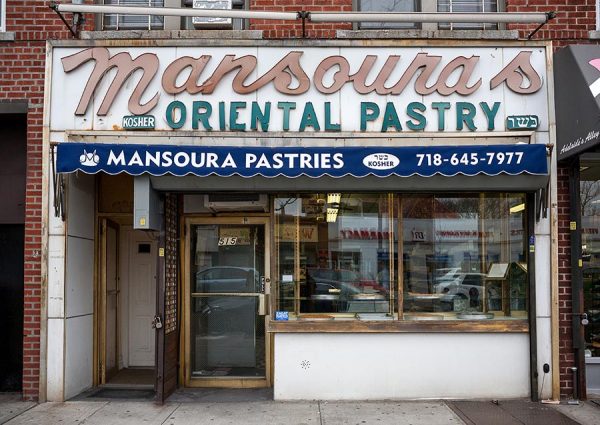
Photo: James and Karla Murray
She told us that, “Americans think of the word Oriental as referring to Chinese but really the word Orient refers to land in the Near East, the Far East and the Middle East. People that are not familiar with us even think that we sell Chinese pastries and even the telephone book around 10 years ago mistakenly listed us under the Oriental heading in the yellow pages. We had to call them and have them change the listing in the book and explain that even though our name says Oriental it is NOT the Oriental that they were thinking of when categorizing our business.”
We had made that same mistake, thinking the shop sold Moon Cakes like we find in Chinatown!
There’s a good chance that your diligent documentation of the city’s storefronts has yielded emotional ties with the inanimate facades. Do you ever find yourselves feeling bummed when a great, longstanding storefront is renovated or redesigned?
Nearly 75% of the 325 stores we had photographed for our first book on the subject, Store Front: The Disappearing Face of New York, published in 2008, have already disappeared. (When we wrote our introduction to the book in 2008, only 1/3rd of the businesses had closed). Even in our latest Store Front II book, which was just recently published, over 25 percent of the small businesses we documented have closed.
We noticed very early on in the project, that if the owner did not own the entire building, their business was already in jeopardy of closing. The owners themselves frequently acknowledged that they were at the mercy of their landlords and the ever-increasing rents they charged. Due to the commonality of high rent increases, after the business had closed, it was often replaced by a chain-type store or banking institution, which could afford the higher rent or the whole building was converted into a luxury condo. If the location was too small a footprint or the locale was deemed undesirable by a chain-type store, the space often remained vacant, sometimes for years.
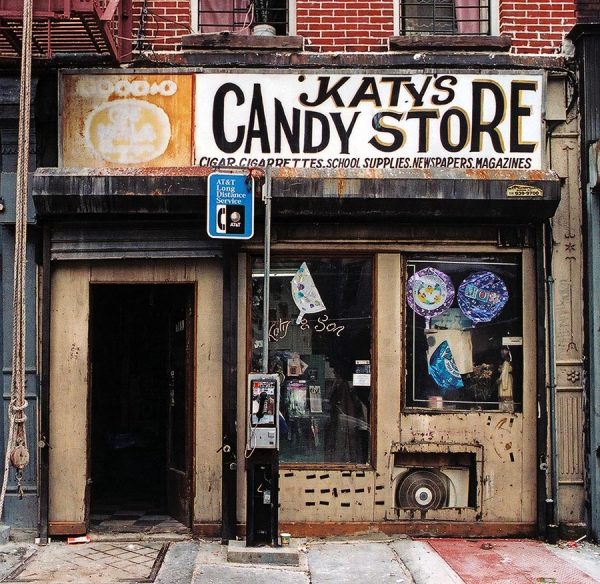
Photo: James and Karla Murray
Speaking to the owners who knew that there store would be closing soon was extremely sad for us. We became very attached to the stores and their stories and often wished that we could somehow save the store. We developed such a personal connection and in many times a friendship with the store owners after spending many hours photographing their store and speaking with them.
We remember that when Mike, the 76-year-old owner of D. D’Auria and Sons Pork Store in the “Little Italy of the Bronx” told us that he didn’t have any children of his own to take over the family business, we actually thought about learning his recipe on how to make all of the pure pork sausages and salami he sold so that we could take over the business when he retired.
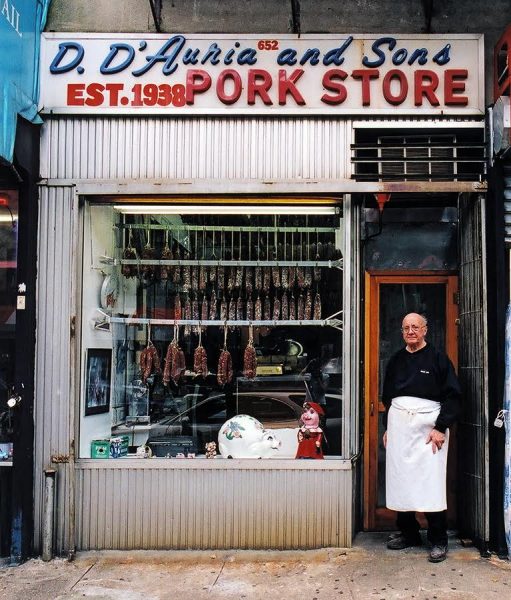
Photo: James and Karla
One of the most distinguishing elements about your work is that publishing them as books seem to be at the forefront of focus, while your Instagram account seems to play as more of a compliment. In an day and age when everyone is fantastically quick to post to Instagram first, what draws you both to morphing all of your work into a physical edition first and foremost?
When we first began documenting the storefronts of New York City in the late 1990s, it was just a personal project and we kept all of the 35mm film archived in storage. We honestly didn’t think that anyone but ourselves would be interested in seeing the photos or hearing the oral histories.
After amassing quite a collection of photos and interviews with the store owners, we were encouraged by our publisher Gingko Press to think about putting them all in book form. This happened before social media was the force it is today. Publishing our work in book form made sense to us, especially because we were fans of analog photography, and created our first Store Front book using entirely 35mm film and a small handheld micro cassette recorder to record the store owner interviews.
Our choice to use 35mm film rather than a digital camera was obvious to us as we wanted to remain old-school like the stores we were documenting. Even when social media accounts like Instagram started to take off, we still concentrated our time and efforts into documenting the small stores and collecting interviews, and were not actively sharing them with the world via social media. Today, we realize that in order for our project to continue to act as an artistic intervention and to help draw attention to and preserve the small shops, we need to help get the message out to everyone to shop small.
We don’t expect that all the forces that cause these stores to close can be stopped but supporting small mom-and-pop stores by shopping in them definitely helps stem the tide.
Last one. Can you give us one street in Manhattan that every human with an appreciation for lovely facades and storefronts should stroll down?
One of our favorite neighborhoods to photograph facades and storefronts would be the East Village and Lower East Side of Manhattan. It is definitely hard to narrow down a single street because there are quite a few, but if we had to pick two, they would be East 11th Street between 1st and 2nd Avenue as it still has many beautiful old tenement buildings and small mom-and-pop shops and has two old Italian food businesses, each well over 100 years old, that stand next door to one another in a rather symbiotic relationship, Russo”s Mozzarella & Pasta and Veniero’s Pasticerria.
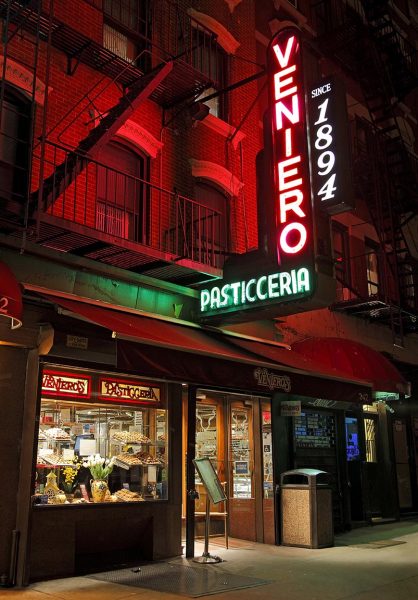
Photo: James and Karla Murray
The other street would be East Houston Street between Ludlow and Chrystie Streets. Even though this street is more well known it is worth seeing the juxtaposition of the centuries old businesses including Katz’s Delicatessen (since 1888), Russ & Daughters Appetizers (since 1914) and Yonah Schimmel Knish Bakery (since 1910) vs. the shiny new multi-story glass towers that have been erected recently.
Follow James and Karla on their ongoing mission to document attractive store fronts and businesses in NYC via their Instagram @JamesandKarla + website.

